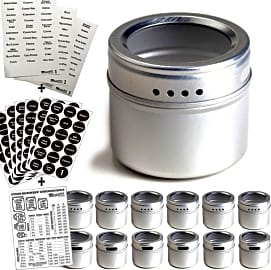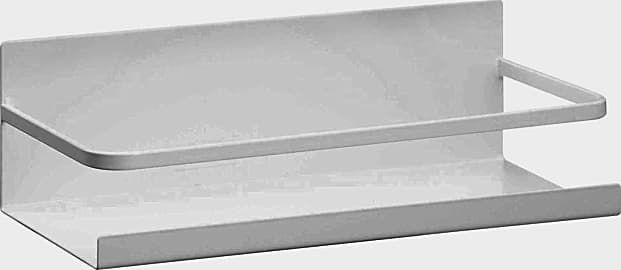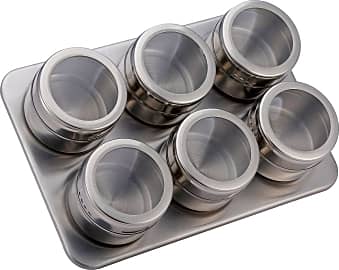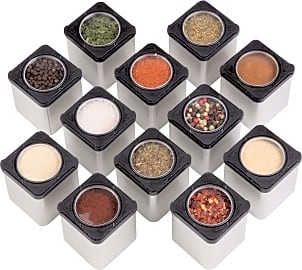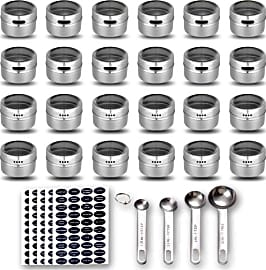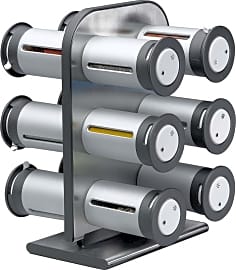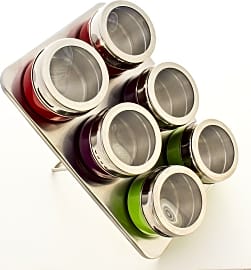The 10 Best Magnetic Spice Racks

This wiki has been updated 43 times since it was first published in May of 2016. Whether you prefer the classics, like salt, pepper, and garlic powder, or you're more partial to exotic flavors, seasonings are some of a cook's most important ingredients. These magnetic spice racks allow you to access your stash without searching in cluttered and disorganized cupboards or drawers. Mount one just about anywhere or decorate your metal appliances with individual containers. When users buy our independently chosen editorial picks, we may earn commissions to help fund the Wiki.
Editor's Notes
March 08, 2019:
Removed the MM Electronics Space Saver due to multiple reports of the magnets being rather weak. And, while five years of free spice refills is a nice perk, it wasn't enough to redeem the Kamenstein 31112's design flaws, including lids that fall off and magnets that detach from the containers. The jars of the Gneiss DIY Hexagon are made of sturdy glass, and they interlock for a neat presentation, or you can configure them to create fun shapes and patterns on your fridge. The Pro Chef Kitchen Tools and Zoie + Chloe Set come with metal stands, but if you don't need a stand or wall plate, go for the Hanindy Storage or Good Cooking Shake or Pour. The Yamazaki Home Plate and Good Cooking Gripper Clips are ideal for those who prefer to use their own jars.
The Magnificent Magnetic Spice Rack
Altogether, you're bound to save some time by using one of these helpful kitchen organizers.
You know you've truly reached adulthood when you buy a spice rack — no more seasoning with leftover ramen noodle packets. But for an item that seems simple (it's jars, you know?), there's actually quite a dizzying variety of spice rack organizational options, including in-cabinet stands, rotating racks, pantry door organizers, in-drawer trays, and more. Fortunately, there's one choice that will work for most kitchens thanks to its combination of usability and aesthetics, and that's the magnetic spice rack.
For one thing, a magnetic spice rack won't require you to hunt through rows of bottles, pulling each one out until you get to the one you need, the one that's all the way in the back, of course. The bottles that come with many magnetic versions have clear lids, so you can see at a glance what's inside each one, and most include labels, as well. Altogether, you're bound to save some time by using one of these helpful kitchen organizers.
But don't worry, because "helpful organizer" doesn't mean it will hog all your space, crucial if you're living in a shoebox-sized dwelling. Instead of taking up valuable counter, cupboard, or drawer space, a magnetic spice rack will take advantage of those areas that may be hard to utilize in other ways, like your refrigerator door (passive aggressive notes between roommates or significant others will have to go elsewhere). If you don't have a metal surface at hand, don't fret, as many magnetic spice racks come with a base for hanging.
Then, there are the benefits that go beyond the utilitarian, as a visually appealing magnetic spice rack will bring some elegance to your kitchen. Ultra versatile, the spice jars in magnetic sets are nowadays usually glass or stainless, so they'll match just about any decorating scheme you can conceive of, from vintage shabby chic to ultra-modern. Your motley assortment of grocery store spice jars, by contrast, looks like clutter when kept out in view. And really, nothing says "I've got my life together" like a matching set of shiny jars, tidily nestled together (just add a bowl of lemons and you're good to go).
What Exactly Are Spices?
If you're ready to take the plunge with a magnetic spice rack, you're probably already aware that spices can have some sweet bonuses, from flavoring the food you eat to preventing disease. But have you ever considered what spices are and where we get them? Or who first had the idea to use them?
These parts include the stem, roots, bark, seeds, bulb, and any other part you can name that isn't the leafy foliage, which gets its own term: herbs.
When defined precisely, spices are the dried parts of plants that we use for flavoring foods besides the leaves. These parts include the stem, roots, bark, seeds, bulb, and any other part you can name that isn't the leafy foliage, which gets its own term: herbs. For example, cinnamon, a spice, comes from dried bark (yum), while dried basil, an herb, comes from the leaves of the Ocimum basilicum plant. In casual conversation, however, many people won't make such distinctions and might call everything they put in their magnetic rack a spice, including those that are technically herbs.
Spices and herbs have been used for thousands and thousands of years by cultures from across the globe, from the ancient Egyptians to the Chinese and beyond. There is even evidence to suggest that the earliest hunter-gatherers wrapped their foods in leaves for the taste and perhaps even the medicinal effects. Ancient peoples chose spices not just for their flavors, though. Various spices developed religious signification, took on important roles in food preservation, and even functioned as forms of currency.
Out of all the spices used for commerce, food flavoring, and health across the history of the world, one that could arguably be called the most influential is salt — but salt is not technically a spice at all. Table salt is non-organic, not a living plant, and thus doesn't fit the technical definition applied to spices, although it has been used just like other spices for thousands of years.
Must-Have Herbs And Spices
Your average cooks usually fall into two groups: those who're happy to experiment with herbs and spices and those who cling nervously to their salt and pepper. No matter your comfort level with new seasonings, we've got some ideas for the basics that will perfectly fill out your new magnetic spice rack. None are exorbitantly expensive, and they'll give you plenty of options from sweet to savory, helping you wow your guests with both your organizational skills and cooking prowess.
Ground ginger is an especially excellent choice, as it naturally soothes upset stomachs and inflammation.
If you love stew, chili, meatballs, or goulash — any of your hearty winter foods — then a supply of paprika, chili powder, and bay leaves should be at the top of your list. Paprika and chili powder can add a hint of spicy flavor to your dishes, and both are available in sweet varieties for those less tolerant to heat. Bay leaves offer a light flavor that some describe as a mix of mint and black pepper; they add a subtle but welcome touch, but note that you should remove the leaves from the dish before serving.
For those who enjoy experimenting with Middle Eastern or Indian recipes, cumin, turmeric, ginger, coriander, and cardamom should be the spices you keep on hand, at the very minimum. Each is fragrant and will help you create a complex, bold flavor whether you're cooking meat or meatless dishes. Ground ginger is an especially excellent choice, as it naturally soothes upset stomachs and inflammation.
Got a sweet tooth? Grab some cinnamon, allspice, nutmeg, cloves, and vanilla bean. These all commonly feature in pies, custards, tarts, cookies, cakes, puddings — well, you get the picture. You can purchase all of these pre-ground or grind them fresh when you're ready to use them (a coffee grinder or mortar and pestle work well for this). Also, note that nutmeg can have unpleasant effects in large quantities, so make sure you've got a good set of measuring spoons and cups on hand.



